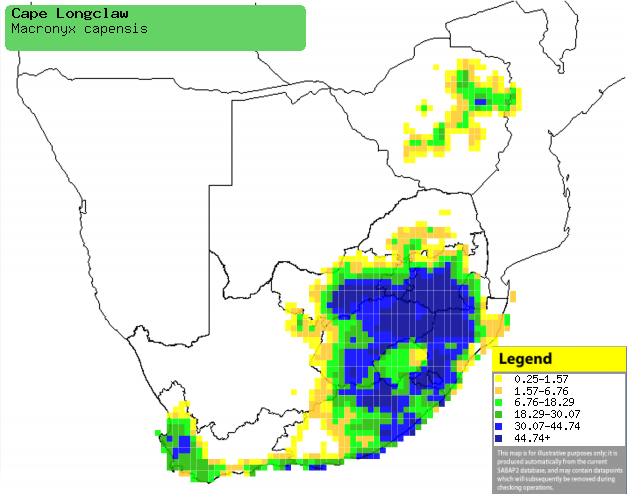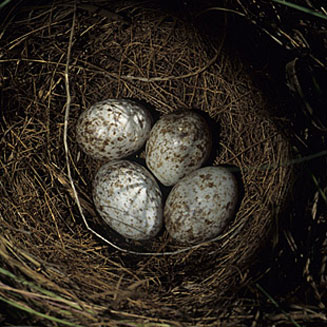|
Macronyx capensis (Cape
longclaw, Orange-throated longclaw)
Oranjekeelkalkoentjie [Afrikaans]; Inqilo [Xhosa]; iNqomfi
[Zulu]; Lethoele, Mahlakali [South Sotho]; Holiyo, Hwiyo (generic terms
for longclaw) [Tsonga]; Kaapse langklauw [Dutch]; Sentinelle du Cap
[French]; Kapgroßsporn [German]; Unha-longa-de-garganta-laranja
[Portuguese]
Life
> Eukaryotes >
Opisthokonta
> Metazoa (animals) >
Bilateria >
Deuterostomia > Chordata >
Craniata > Vertebrata (vertebrates) > Gnathostomata (jawed
vertebrates) > Teleostomi (teleost fish) > Osteichthyes (bony fish) > Class:
Sarcopterygii (lobe-finned
fish) > Stegocephalia (terrestrial
vertebrates) > Tetrapoda
(four-legged vertebrates) > Reptiliomorpha > Amniota >
Reptilia (reptiles) >
Romeriida > Diapsida > Archosauromorpha > Archosauria >
Dinosauria
(dinosaurs) > Saurischia > Theropoda (bipedal predatory dinosaurs) >
Coelurosauria > Maniraptora > Aves
(birds) >
Order: Passeriformes > Family: Motacillidae
> Genus: Macronyx
Distribution and habitat
Endemic to southern Africa, occurring in two separate
areas: Zimbabwe and adjacent Mozambique as well as South Africa, Lesotho and
Swaziland (absent from the karoo and Kalahari). It generally prefers moist short
grassland and fynbos, also occupying pastures and the edges of vleis.
|
 |
|
Distribution of Cape longclaw in southern Africa,
based on statistical smoothing of the records from first SA Bird Atlas
Project (©
Animal Demography unit, University of
Cape Town; smoothing by Birgit Erni and Francesca Little). Colours range
from dark blue (most common) through to yellow (least common).
See here for the latest distribution
from the SABAP2. |
Food
It mainly eats insects supplemented with seeds, doing most
of its foraging on the ground, plucking food from vegetation and hawking prey
aerially. The following food items have been recorded
in its diet:
Breeding
- Monogamous territorial solitary nester, with males performing displays in
which they flutter to about 10 metres above ground while singing, before
dropping down again.
- The nest (see image below) is built solely by the female, consisting of
a deep cup of coarse grass stems lined with fine rootlets, typically well
concealed between two grass tufts.
 |
|
|
Cape longclaw nest with eggs, Wakkerstroom, South
Africa. [photo Warwick Tarboton ©] |
|
- Egg-laying season is almost year-round, peaking from August-October in the
Western Cape, but from November-January elsewhere.
- It lays 1-4 eggs, which are mainly incubated by the female for about
13-14 days.
- The chicks are fed by both parents, leaving the nest after approximately
13-14 days.
Threats
Not threatened.
References
-
Hockey PAR, Dean WRJ and Ryan PG 2005. Roberts
- Birds of southern Africa, VIIth ed. The Trustees of the John Voelcker
Bird Book Fund, Cape Town.
|
